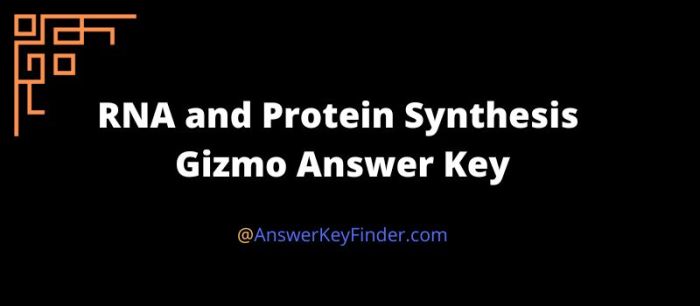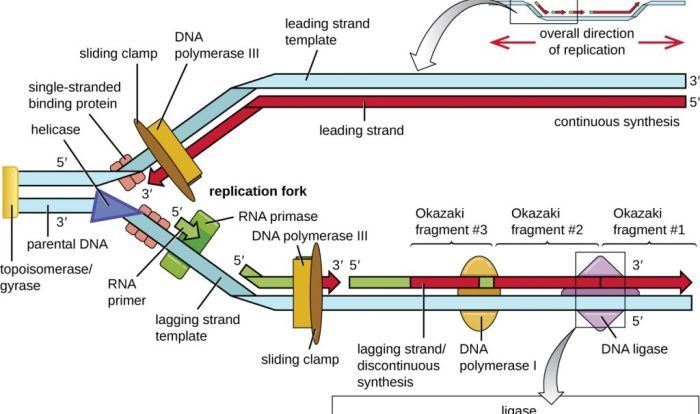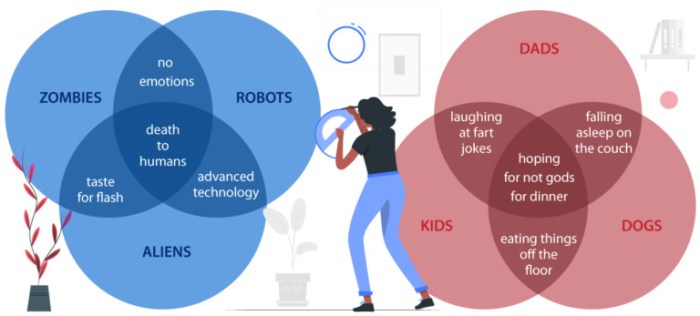Rna protein synthesis gizmo answers – Welcome to the world of RNA protein synthesis, where the secrets of life unfold. This guide will unveil the mysteries of this complex process, using the interactive RNA Protein Synthesis Gizmo as our trusty companion. Prepare to delve into the depths of gene expression, unraveling the intricate dance between DNA, RNA, and proteins.
Our journey begins with a closer look at the Gizmo’s user-friendly interface. We’ll explore its buttons, sliders, and tabs, each playing a vital role in simulating the intricate steps of RNA protein synthesis. With this knowledge, we’ll embark on setting up simulations, selecting DNA sequences, and adjusting parameters to mimic real-world scenarios.
Introduction
RNA protein synthesis is a fundamental cellular process that plays a crucial role in the production of proteins, which are essential for various biological functions. This process involves the transcription of DNA into RNA and the subsequent translation of RNA into proteins.
Gizmo is a virtual simulation tool that allows users to explore and understand biological processes. In the context of RNA protein synthesis, Gizmo provides a simulated environment where users can observe the steps of transcription and translation and investigate the factors that influence these processes.
Gizmo Interface

The RNA protein synthesis gizmo has a user-friendly interface designed to facilitate exploration and understanding of the complex processes involved in protein synthesis. The gizmo’s layout consists of several key components:
- Workspace:The central area of the gizmo where users can manipulate molecules, observe interactions, and run simulations.
- Tabs:Located at the top of the gizmo, these tabs provide access to different stages of the protein synthesis process, including transcription, translation, and mutation.
- Buttons:Various buttons are located throughout the gizmo, allowing users to control the simulation, zoom in and out, and access additional features.
- Sliders:Sliders are used to adjust parameters such as the rate of transcription and translation, enabling users to explore the effects of different conditions on the process.
- DNA/RNA/Protein Sequences:These sequences are displayed in the gizmo, providing a visual representation of the genetic information being processed.
Buttons
The gizmo features several buttons that serve specific functions:
- Play/Pause:Starts or pauses the simulation.
- Reset:Resets the simulation to its initial state.
- Zoom In/Out:Allows users to zoom in and out of the workspace.
- Show/Hide Labels:Toggles the display of labels for molecules and structures.
- Toggle 3D View:Switches between 2D and 3D representations of molecules.
Sliders
The gizmo includes several sliders that allow users to adjust simulation parameters:
- Transcription Rate:Controls the speed at which DNA is transcribed into RNA.
- Translation Rate:Controls the speed at which RNA is translated into protein.
- Mutation Rate:Determines the probability of mutations occurring during transcription and translation.
Simulation Setup
To simulate RNA protein synthesis using the Gizmo, you must first set up the simulation parameters. These parameters include the DNA sequence, the simulation speed, and the number of ribosomes.
To select the DNA sequence, click on the “DNA” tab. You can then enter a custom DNA sequence or select one of the pre-defined sequences. Once you have selected a DNA sequence, you can adjust the simulation parameters by clicking on the “Settings” tab.
Here, you can set the simulation speed and the number of ribosomes.
Running the Simulation
To run the simulation, click on the “Play” button. The simulation will then run until it is complete. You can pause the simulation at any time by clicking on the “Pause” button. You can also reset the simulation by clicking on the “Reset” button.
Simulation Analysis
The simulation results provide valuable insights into the protein synthesis process. By analyzing the generated data, users can evaluate the accuracy and efficiency of the process, identify errors or mutations, and explore the relationship between gene sequences and protein structure.
The simulation generates several key data sets, including the mRNA sequence, amino acid sequence, and codon usage table. The mRNA sequence represents the transcribed messenger RNA molecule, which carries the genetic information from DNA to the ribosome for protein synthesis.
The amino acid sequence represents the sequence of amino acids in the synthesized protein. The codon usage table shows the frequency of each codon used in the mRNA sequence.
Interpreting the Results
To interpret the results, users should first examine the mRNA sequence. The sequence should match the DNA template strand used for transcription. Any mismatches or errors in the mRNA sequence can indicate transcription errors or mutations. Next, users should examine the amino acid sequence.
The amino acid sequence should correspond to the genetic code, as determined by the mRNA sequence. Any mismatches or errors in the amino acid sequence can indicate translation errors or mutations.
Identifying Errors or Mutations
The gizmo provides several tools to help users identify errors or mutations in the protein synthesis process. The “Error” button highlights any mismatches or errors in the mRNA or amino acid sequences. The “Mutation” button introduces random mutations into the DNA template strand, allowing users to observe the effects of mutations on the protein synthesis process.
Advanced Features
The Gizmo offers advanced features that enable deeper exploration of RNA protein synthesis. These features include mutation analysis, protein folding, and gel electrophoresis, providing valuable insights into various aspects of the process.
Mutation Analysis, Rna protein synthesis gizmo answers
Mutation analysis allows the user to introduce mutations into the DNA sequence and observe their effects on protein synthesis. By analyzing the resulting changes in protein structure and function, researchers can gain insights into the impact of mutations on gene expression and the development of genetic diseases.
Protein Folding
Protein folding is a crucial step in protein synthesis. The Gizmo’s protein folding feature allows the user to visualize the process of protein folding and identify the factors that influence the formation of the correct protein structure. This feature can aid in understanding protein stability, function, and the development of protein-based therapeutics.
Gel Electrophoresis
Gel electrophoresis is a technique used to separate proteins based on their size and charge. The Gizmo’s gel electrophoresis feature enables the user to analyze the products of protein synthesis and determine the molecular weight of the resulting proteins. This feature is useful for identifying proteins of interest, characterizing protein mixtures, and diagnosing genetic disorders.
Educational Applications: Rna Protein Synthesis Gizmo Answers
The RNA Protein Synthesis Gizmo provides an interactive and engaging platform for educators to teach students about the fundamental processes of protein synthesis. This versatile tool can be integrated into lesson plans and activities to enhance student understanding of gene expression and its role in cellular function.
Lesson Plans and Activities
-
-*Interactive Simulations
Students can use the Gizmo to simulate the transcription and translation processes, manipulating variables such as DNA sequence and RNA polymerase activity. This hands-on experience allows students to visualize and experiment with the molecular mechanisms underlying protein synthesis.
-*Concept Exploration
The Gizmo can be used to introduce key concepts related to protein synthesis, such as the genetic code, codon usage, and the role of tRNA in amino acid incorporation. By exploring these concepts through interactive simulations, students can develop a deeper understanding of the molecular basis of protein synthesis.
-*Assessment Tool
The Gizmo can serve as an effective assessment tool to evaluate student understanding of protein synthesis. Educators can assign tasks that require students to analyze simulated results, make predictions, and explain the molecular mechanisms involved in gene expression.
-*Personalized Learning
The Gizmo’s customizable settings allow educators to tailor simulations to the specific needs and interests of their students. This flexibility enables personalized learning experiences, allowing students to explore concepts at their own pace and focus on areas where they need additional support.
Enhancing Student Understanding
-
-*Visual Representations
The Gizmo’s animations and interactive visualizations provide a clear and engaging way for students to visualize the complex processes of transcription and translation. This visual representation helps students to grasp the molecular mechanisms underlying protein synthesis and appreciate the intricate choreography of cellular processes.
-*Interactive Exploration
The Gizmo allows students to manipulate variables and observe the resulting changes in gene expression. This interactive exploration enables students to develop a deeper understanding of the cause-and-effect relationships between molecular mechanisms and protein synthesis outcomes.
-*Problem-Solving Skills
The Gizmo encourages students to think critically and solve problems related to protein synthesis. By simulating different scenarios and analyzing the results, students can develop their problem-solving skills and apply their knowledge to real-world contexts.
Key Questions Answered
What is RNA protein synthesis?
RNA protein synthesis is the process by which cells use the information encoded in DNA to produce proteins, the building blocks of life.
How does the RNA Protein Synthesis Gizmo help?
The Gizmo provides an interactive simulation of RNA protein synthesis, allowing students to visualize and experiment with the process in a virtual environment.
What are the benefits of using the Gizmo in education?
The Gizmo can enhance student understanding of protein synthesis, promote critical thinking, and foster problem-solving skills.



